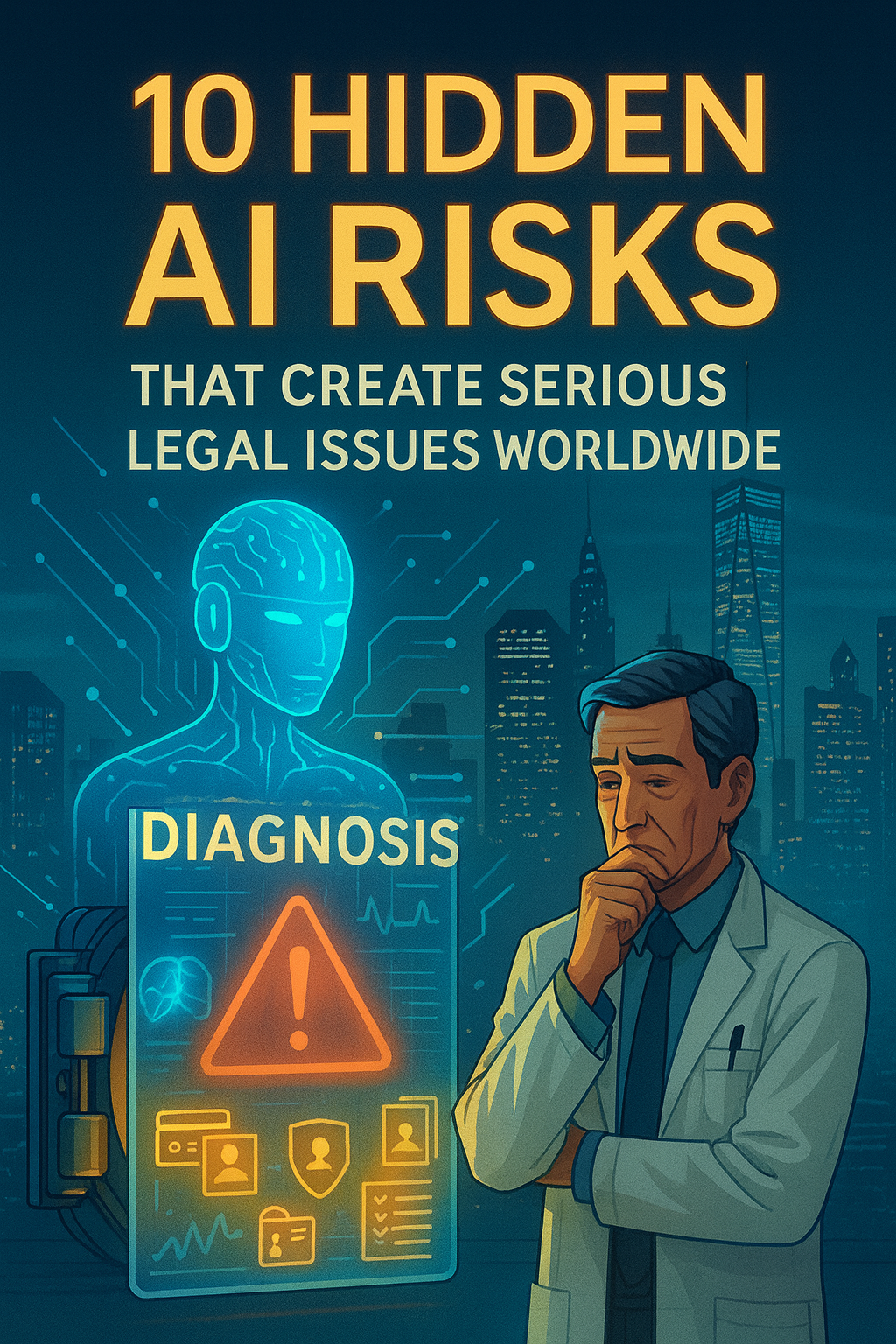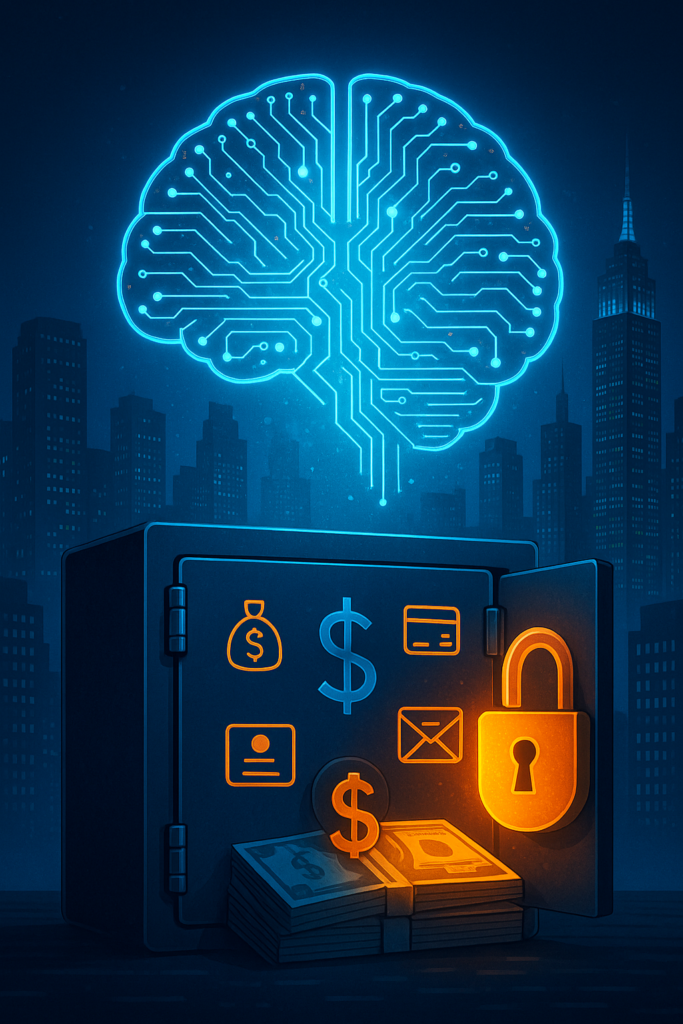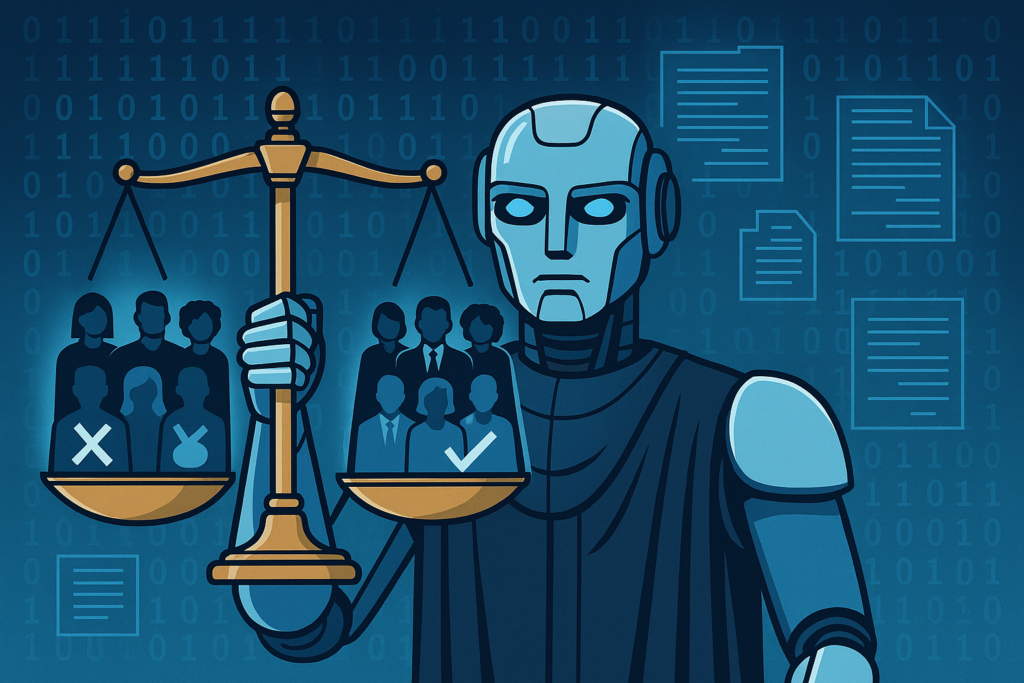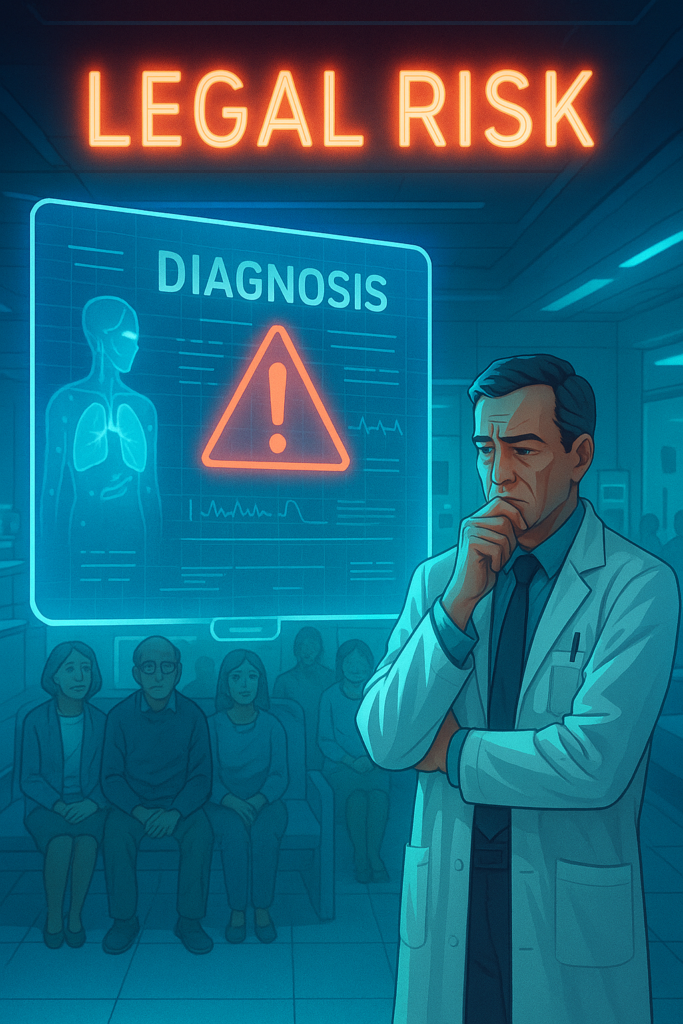Physical Address
304 North Cardinal St.
Dorchester Center, MA 02124
Physical Address
304 North Cardinal St.
Dorchester Center, MA 02124

AI risks are becoming one of the biggest concerns in today’s world. At the same time, a New York City financial firm faced questions when its loan approval system unfairly rejected people based on biased data. These real stories show how fast artificial intelligence can turn from a helpful tool into a serious legal problem.
Finance and healthcare are two of the most sensitive areas in modern life. Banks, insurance companies, and what financial institution leaders depend on AI to make faster and cheaper decisions. Hospitals and clinics use AI to manage patient records and improve diagnosis. But when these systems fail, the legal risks are huge. Customers may lose money, patients may suffer harm, and companies can face heavy penalties from regulators.
This is why understanding healthcare content rules and financial laws is so important. For example, in banking, AI can affect financial literacy definition because people must understand how automated systems decide on loans, credit scores, or investments. In healthcare, patients need clear consent and transparency about how their private data is being used. Without strong rules, the promise of AI can easily become a risk to safety and trust.

This blog will explore the biggest challenges of AI in finance and healthcare. It will look at seven key AI risks that create problems for companies, professionals, and customers. Topics include data misuse, bias, accountability, fraud, malpractice, and regulation gaps. The aim is to show how firms can reduce these risks while keeping innovation alive. By the end, readers will see why managing AI risks is not just about technology but also about law, ethics, and public confidence.
Artificial intelligence is changing how businesses work in many sectors, but the dangers are greatest in areas where rules are very strict, such as finance and healthcare. These industries handle money, health, and personal information, which makes them sensitive to mistakes. If AI systems fail or misuse data, the damage can be huge. That is why AI risks are more serious in these sectors than in many others.
AI risks are the problems that can come when machines make decisions without full human control. In finance, this could mean unfair lending, wrong investment choices, or missed fraud detection. For example, if a what financial institution relies too much on AI to approve loans, a biased algorithm might deny fair access to credit. In healthcare, risks appear when AI misreads test results or fails to protect patient records, which are part of sensitive healthcare content. These mistakes can lead to lawsuits, penalties, and loss of public trust.
Because of these dangers, laws and regulations are central. Financial regulators require firms to prove that systems are fair, transparent, and safe for customers. Concepts such as financial literacy definition show why people need to understand how financial decisions are made, especially when AI is involved. In healthcare, privacy rules like HIPAA demand that patient information is stored and shared correctly. Breaching these rules can create serious legal risks for hospitals and clinics.
Finance deals with large sums of money, customer data, and public stability. A wrong move by an AI model can affect markets across New York City financial firms or even entire economies. Healthcare, on the other hand, deals directly with human life. AI systems in diagnosis, treatment, and record keeping must be accurate and safe because errors can harm patients.
Artificial intelligence has become a normal part of the financial world. Banks, lenders, and what financial institution leaders now use AI for loan approvals, credit scoring, fraud checks, and even stock trading. These tools promise speed and efficiency, but they also create AI risks that can damage trust and bring serious legal risks. Finance is one of the most regulated industries, and any mistake can bring fines, lawsuits, or loss of reputation.
Every financial company collects sensitive customer data. This includes income records, spending history, and even health data when applying for insurance. If AI systems mishandle this information, the results can be devastating. A single data leak in a New York City financial firm could expose thousands of clients and lead to multimillion-dollar penalties. Laws like GDPR and the Financial Intelligence Centre Act make clear that companies are responsible for secure handling of personal data. For banks and lenders, ignoring compliance is one of the biggest AI risks.

AI models are trained on past data, and past data often carries bias. If a loan algorithm rejects applications unfairly, it is not just unethical — it is illegal. Discrimination in lending is a breach of financial law. Imagine a system where women or minority groups are denied loans because of biased data patterns. This type of case has already raised attention among regulators and consumer groups. For companies like bread financial or ameriprise financial, biased algorithms could mean lawsuits, fines, and loss of customers’ trust.
When AI makes a wrong call, the question is: who takes the blame? If an AI system gives poor investment advice, does the fault lie with the programmer, the financial advisor, or the bank? Courts are still debating this, and the uncertainty itself is a legal risk. Financial firms such as financial trust providers need clear governance. Human managers must stay in control and be ready to explain AI-driven decisions. Without accountability, customers may lose faith in both the technology and the financial institution itself.
AI is often praised for its ability to detect fraud, but over-reliance can also create new problems. For example, banks may trust fraud alerts too much without double-checking with human oversight. If an AI system fails to spot fraud or wrongly flags genuine transactions, customers may lose access to their money. This can create lawsuits and reputational harm. Regulators expect firms to balance AI efficiency with human judgment. A large financial institution in the New York City financial market could face huge penalties if it wrongly blocks accounts or misses criminal activity that the Financial Crimes Enforcement Network FinCEN is monitoring.
Another important legal issue is ownership of AI-generated tools. Many financial companies build custom algorithms for investment analysis, credit scoring, or risk management. But who owns the rights — the developer, the financial company, or the AI itself? Disputes can arise if a former employee takes algorithms to a competitor or if open-source models are used without proper licensing. For example, firms like wings financial or principal financial group 401 k must ensure contracts clearly state ownership and intellectual property terms. Without this clarity, AI models could become the center of costly legal battles.
AI in finance creates opportunities but also big risks. Firms face problems with privacy, bias, fraud errors, and ownership rights. Regulators demand stronger rules, and customers want trust. Financial companies must combine innovation with responsibility. Only those who keep human control and follow fair practices will build lasting trust and avoid legal trouble.
Artificial intelligence is reshaping medicine, from reading X-rays to handling patient records. Hospitals, clinics, and research centers are using AI to improve speed and accuracy. But like in finance, there are serious AI risks here too. Healthcare deals directly with human lives, which makes mistakes far more dangerous. Misuse of healthcare content, privacy breaches, or wrong medical advice can quickly turn into legal risks for hospitals, doctors, and technology providers.

Healthcare systems collect huge amounts of sensitive data such as medical histories, lab results, and genetic information. AI tools depend on this information to function. If hospitals or AI providers fail to follow privacy rules like HIPAA in the US or GDPR in Europe, they face lawsuits, fines, and reputational damage. Imagine a case where patient scans are accidentally shared online due to weak AI security. This would not only break privacy laws but also destroy patient trust. Just as a financial institution must protect bank details, healthcare providers must protect medical details.
AI is increasingly used to analyze scans, blood tests, and symptoms. While powerful, these systems are not perfect. If an AI tool fails to detect cancer in a scan or gives a wrong treatment recommendation, the consequences can be life-threatening. Such mistakes can trigger malpractice lawsuits against hospitals and doctors. Courts are now questioning who is legally responsible — the doctor who used the tool or the company that built the AI. This uncertainty makes AI diagnostic errors one of the most serious legal risks in healthcare.
Another problem comes when patients are not told that AI is part of their treatment. If a hospital uses AI to decide medication without informing the patient, it can be challenged in court for lack of consent. Patients have the right to know how their data and treatment are managed. Transparency is essential to maintain trust, and without it, AI risks turn into legal disputes.
One of the biggest AI risks in healthcare is deciding who is responsible when something goes wrong. If a doctor follows an AI recommendation and it harms the patient, who should be blamed — the doctor, the hospital, or the AI company? Courts are still debating these questions. For example, in 2020, an AI tool in the UK misclassified some cancer scans, leading to delayed treatments. While no single doctor was directly responsible, patients still suffered. This type of case shows how legal risks grow when accountability is unclear. Hospitals must create policies to define roles and make sure doctors remain the final decision-makers.
Healthcare is highly regulated, yet many AI systems reach hospitals before full approval. In the United States, the FDA has warned that some medical AI tools are being used without enough testing. In one case, an AI for stroke detection gave inconsistent results, raising safety concerns. Using unapproved technology exposes hospitals to legal action. Just like what financial institution leaders must respect banking rules, healthcare providers must follow strict approval steps. Without these safeguards, the use of AI can cross into dangerous territory.
The risks of AI in healthcare go beyond single errors. They touch on healthcare content management, patient safety, and public trust. Lawsuits, fines, and media coverage can quickly damage a hospital’s reputation. For example, a lawsuit in California in 2022 claimed that an AI-powered health insurer wrongly denied treatments, showing how legal disputes are spreading across the industry. These cases prove that healthcare providers must balance innovation with caution.
In short, the legal risks in healthcare include privacy breaches, diagnostic errors, lack of consent, malpractice disputes, and weak regulatory approval. Each of these risks threatens not only patients but also the stability of healthcare systems. Strong oversight, clear policies, and transparent communication are the only way to reduce harm and maintain trust.
Artificial intelligence is changing both finance and healthcare, but the AI risks are not the same in these two sectors. What they share is the need for strong rules, public trust, and clear accountability. Both areas deal with very sensitive information. A mistake in finance may cost money while a mistake in healthcare may cost lives.
There are several legal issues that both finance and healthcare face. One is data privacy. Banks and what financial institution leaders must protect customer bank accounts while hospitals must protect patient medical records. A data leak in either sector can create lawsuits and destroy trust. Another common issue is accountability. In both finance and healthcare, the question of who is responsible when AI fails is not always clear. Regulators expect human managers to stay in control.
Another theme is public confidence. Customers will only trust AI systems if they believe their rights are protected. For example, financial literacy definition matters in finance because people need to understand how automated credit scoring works. In healthcare, patients need to know how their healthcare content is used and if AI is part of their treatment. Without this transparency, both sectors risk losing customer confidence.
Finance is mainly about money, markets, and contracts. The biggest AI problems are biased lending, fraud detection errors, and intellectual property disputes. For example, the Financial Crimes Enforcement Network FinCEN monitors financial firms to prevent money laundering. If an AI system misses such activity, the firm can face heavy fines.
Healthcare is more about safety and human life. The main issues are malpractice, diagnostic errors, and regulatory approvals. A wrong medical recommendation can harm a patient immediately, which is why courts treat healthcare mistakes very seriously.
While finance focuses on stability and preventing fraud, healthcare focuses on protecting lives. Both industries need strong laws and ethical AI use. Governments are now creating new rules to guide AI in sensitive areas. The European Union has even proposed the AI Act to set standards for safe and fair AI across all industries. You can read more about it on the official EU website here: European Commission AI Act.
In short, finance and healthcare face different but equally serious legal risks. To benefit from AI, both must protect people’s rights, follow strict laws, and keep human control at the center of decision making.
Real examples help us understand how AI risks create real-world problems. Both finance and healthcare have already seen legal disputes where artificial intelligence played a central role. These cases show the dangers of using technology without strong control.
In 2020, a New York City financial firm faced questions about its loan approval system. The company used an AI tool to check credit scores and approve loans. However, the algorithm was found to reject a high number of applications from minority groups. This created discrimination concerns. The case raised serious legal risks because financial law requires fair lending to all groups. Regulators argued that the firm did not explain clearly how its AI made decisions. Customers also said that the lack of transparency harmed their trust. This situation also linked to financial literacy definition since people could not fully understand or challenge how decisions were made. It showed how AI can create bias if not monitored properly.
In healthcare, one well-known issue happened when an AI system used to predict which patients needed extra care gave unfair results. The system relied on past spending records instead of actual health needs. As a result, many patients who required treatment did not receive it. This misuse of healthcare content raised legal risks because it put patient safety at risk and could be seen as negligence. Hospitals had to review their practices and prove to regulators that they were following proper standards.
These two examples show that what financial institution leaders and hospital managers must be careful when using AI. Finance must make sure credit and investment decisions are fair, while healthcare must ensure that patient safety comes first. In both cases, transparency, human oversight, and strong rules are essential to prevent future disputes.
The best way to handle AI risks in finance and healthcare is to focus on prevention. Companies must understand that technology alone cannot protect them from mistakes. Strong governance, clear rules, and human oversight are the most important steps.
In finance, banks and what financial institution leaders must build systems that are transparent and explainable. Customers should know how credit scores, loans, and investments are decided. This also connects to financial literacy definition because people need the skills to understand and question AI-based decisions. Firms should also test their algorithms for bias and work with regulators to make sure they follow fair lending laws.
In healthcare, hospitals must handle healthcare content such as medical records with strict security. AI tools must be tested carefully before being used on patients. Doctors should always stay in control and explain clearly if AI is used in diagnosis or treatment. This reduces legal risks around malpractice, privacy, and consent.
Overall, the goal is balance. Companies can use AI to improve efficiency but must never forget ethics, law, and trust. With the right safeguards, AI can be both powerful and safe in regulated industries.
The future of AI risks in finance and healthcare will depend heavily on new laws and stronger governance. Governments around the world are working on clearer rules because both sectors are too important to leave unregulated.
In finance, regulators are paying more attention to fairness, bias, and fraud. What financial institution leaders in places like the New York City financial district will soon need to prove that their systems are transparent and safe. This will also push the importance of financial literacy definition, since customers need to understand how AI decisions affect them.
In healthcare, stricter controls will focus on patient safety and data protection. Laws will demand that hospitals manage healthcare content responsibly and test AI tools before real use. International efforts, such as the European Union’s AI Act, show that governments want common standards across countries.
In this blog, we explored how finance and healthcare use artificial intelligence and why it creates serious AI risks. In finance, companies expose themselves to legal risks when they misuse data, allow unfair lending, or depend too much on flawed fraud systems. In healthcare, hospitals risk lives when they fail to protect patient information, give wrong diagnoses, or hide the role of AI in treatment.
The comparison made one truth clear. Both industries must protect privacy, build accountability, and earn trust. The case studies showed how quickly poor AI decisions can turn into lawsuits and damage reputations.
The future does not belong to those who adopt AI the fastest. It belongs to those who use it wisely. Leaders who follow strong laws, stay transparent, and keep people first will unlock the true value of AI.
Learn more at Iceberg AI Content.
Q1. What are AI risks in finance?
AI risks in finance include data misuse, unfair lending, fraud detection errors, and unclear responsibility for mistakes. These create major legal challenges for banks and institutions.
Q2. What are AI risks in healthcare?
In healthcare, AI risks involve privacy breaches, wrong medical diagnoses, lack of patient consent, and weak approval for new tools. These risks can put lives in danger.
Q3. Why are legal risks important in AI?
Legal risks matter because finance and healthcare are heavily regulated. If companies fail to follow rules, they face lawsuits, fines, and loss of trust.
Q4. How can companies reduce AI risks?
Companies can reduce risks by following strong laws, using ethical systems, and keeping human control in decision making.
Q5. What is the future of AI laws?
Governments plan stricter rules like the EU AI Act to protect people’s rights and ensure safe use of AI.